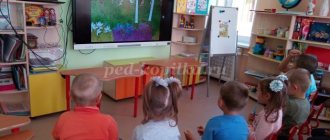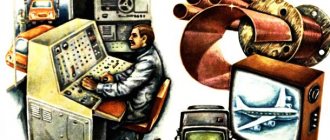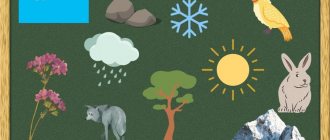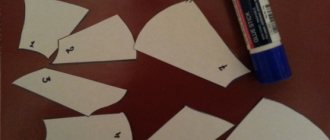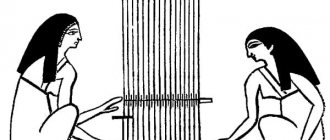Senior group. Senior preschool age. Children 5-6 years old
Additional educational program of preschool education for children 5–6 years old “Merry Logorhythmics” Additional educational program of preschool education on the speech development of children “Merry Logorhythmics ”
The program is designed for children aged 5–6 years Implementation period - 1 year Compiled by: additional education teacher O.V. Dolgaleva 2021 Contents 1. Target section...
Summary of educational activities on speech development with elements of logorhythmics in the senior group “Transport” Goal: Children must learn the names of types of transport (car, bus, tram, plane, rocket, missile, motorcycle, elementary parts of cars (cabin, steering wheel, pedal, body, wheels. Objectives: correctional and educational: 1. Expanding ideas about types of transport. 2. consolidate and…
Open lesson on logorhythmics in the senior group
Scenario for an open lesson on Logori.
Description of the material: Every year our holding hosts Open Days, the purpose of which is to introduce parents to specialists and teachers of additional education, as well as to the methods used in working with children. We present various areas (artistic and aesthetic, creative, physical education, educational) in the form of master classes and open classes. My circle on musical logorhythmics belongs to the artistic and aesthetic cycle and, thinking through the course of the lesson, I decided to devote it to a conversation about rhythm and ways to develop a sense of rhythm in children. Author: Olga Vasilievna Podkolzina, music director of the State Budgetary Educational Institution “School No. 1056” in Moscow. Goal: To interest parents and children in the subject of logorhythmics. Objectives: introduce rhythm games; show ways to develop a sense of rhythm in a child; create a relaxed gaming atmosphere.
Progress of the event
Guests (parents with children) enter the hall to the music. Musical director: Hello, my friends, I am glad to see you all. Our garden is open to guests, parents and their children. I suggest you stand in a circle and start our fun lesson! (Everyone stands in a circle.)
And before we start, we need to greet each other.
Communication game “Hello, friend!” M.Yu. Kartushina 1. The legs walked (Children and parents move scattered around the hall.)
Straight along the path, They met a friend
(Towards the end of the verse they stand in pairs.)
Little legs.
Chorus: Hello, hello, (Holding hands, couples perform a “spring”)
Hello, dear friend, Hello, hello,
(Do a “spring”).
Look around!
(Spread their arms to the sides).
Hello, hello,
(They make a “spring”).
Smile at me!
(Pretend to smile by raising your hands to your chin.)
Hello, hello,
(They make a “spring”).
Bow your head!
(Bow to each other).
2. The legs ran
(They run on their toes scattered around the hall).
Right along the path, Met a friend
(Get into pairs).
Little feet.
Chorus. (Movements are repeated).
3. The legs jumped
(they move around the hall in jumps, kids jump on two legs).
Right along the path, Met a friend
(By the end of the verse they get into pairs).
Little feet.
Chorus. (Movements are repeated). Musical director: Well, now that we have all said hello, I would like to talk to you a little about logorhythmics, about rhythm in general and how you can play with it. What is logorhythmics? This is a system of motor exercises that are combined with words and music. Most often it is used in correctional pedagogy, as well as to stimulate the speech development of children. Rhythm is not only a musical concept, but also a sense of time in general. A good sense of rhythm helps children better master their native language, because our speech also consists of rhythmic formulas, in which stressed and unstressed syllables constantly alternate. If you transfer them to rhythm, you get an alternation of long and short durations. Let me give you an example. My name is Olga VasIlyevna. I will say my name like this - a long syllable and two short ones (ta-ti-ti), a long syllable and two short ones (ta-ti-ti). Now let's stand in a circle. And we'll read out your names. Game “Tap Your Name” Parents and children stand in a circle and pass the ball to the music. When the music ends, the one with the ball in his hands slaps his name. Musical director: You can also clap any poem familiar to the baby. Does everyone know the poem “Teddy Bear”? Let's try to tap him. The clubfooted bear (Ti-ti-ti-ti-Ta-ti)
is walking through the forest.
(Ti-ti-ti-ti-Ta)
Collects cones,
(Ti-ti-ti-ti-Ta-ti)
Sings songs.
(Tee-ti-ti-ti-Ta)
Suddenly a cone fell
(Ti-ti-ti-Ta-ti)
Right in the bear's forehead,
(Ti-ti-ti-ti-Ta)
The bear got angry
(Ti-ti-Ta-Ti-Ti-Ti-Ta
ti-ti-ta-ti) And stomp with your foot!
(Ti-ti-ti-ti-Ta) Musical director: In the development of children's speech, various finger games, pure tongues, and also speech games with movement are actively used, when all actions are performed in accordance with a given rhythmic pulsation. Here is an example of a pure tongue (you can use any problematic sounds for elaboration). Author's pure phrase [l, r, l', r'] La, la, la, (Children walk rhythmically in place).
Winter has come to us, Ra, ra, ra,
(Clap their hands).
Happy kids.
La, la, la, (Swing their lowered arms from side to side).
White earth, Rya, Rya, Rya,
(They rhythmically clench and unclench their fists, while lowering their hands down).
In the light of a lantern.
Musical director: And now I suggest you play a little more! Rhythmic game for younger preschoolers “Jumping” M.Yu. Kartushina 1. Spending, spending! (Children jump on two legs in all directions.)
Let's start jumping!
Jump and jump, jump and jump! You need to jump on your toes. 2. Spending, spending! (Standing still, clap their hands.)
Let's start the crackers!
Clap-clap, clap-clap! Hit your hands - clap-clap-clap! 3. Spending, spending! (They spin around with a stomping step).
Let's start twirling!
Tra-ta, tra-ta-ta! What a beauty! Musical game for middle-aged and older children “Snowball-Kolobok” M.Yu. Kartushina Children and parents stand in a circle and pass the “snowball” around the circle, rhythmically pronouncing the text.
The one who has “snowball” in his hands at the last words goes out with his mother in a circle and dances. Hello, hello, our snowball, Snowy, white bun!
He rolled along the path, and then stopped. Go out onto the path and dance with the snow! Musical director: And, of course, playing in an orchestra, dancing, and any musical rhythmic movements wonderfully develop a sense of rhythm. Let's take our instruments and imagine that we are real musicians. Participants in the meeting take the proposed instruments and perform the proposed piece in the orchestra. Orchestra (at the choice of the music director)
Musical director: And at the end of our meeting, I propose a fun dance. Communicative dance for demonstration (at the choice of the music director) Music director: Our meeting today has come to an end. I hope everyone found it interesting. They played with you happily and didn’t get bored at all, But the time has come to say: “Goodbye! Good morning!" Children and parents leave the hall.
We recommend watching:
The use of ICT in correctional work with preschoolers Summary of GCD in the junior group on logorhythmics Music lesson in the senior group “Spring melodies and sounds” Logorhythmic lessons in kindergarten in the senior group on the lexical topic “Autumn”
Similar articles:
Walk “Wind Watching” in the senior group
Observation in the senior group of kindergarten. It's frosty outside
We develop speech, voice, memory using proven logorhythmic methods.
Contained in sections:
- The work of a speech therapist. Speech therapy 8564
By groups:
- Senior group
- Preparatory group
- Middle group
- Junior group
Showing publications 1-10 of 1497. All sections | Logorhythmics. Logorhythmic exercises
New
Photo
The best
Additional educational program of preschool education for children 5–6 years old “Merry Logorhythmics” Additional educational program of preschool education on the speech development of children “Merry Logorhythmics ”
The program is designed for children aged 5–6 years Implementation period - 1 year Compiled by: additional education teacher O.V. Dolgaleva 2021 Contents 1. Target section...
Scenario of the musical-logorhythmic theatrical lesson “Bag of Apples” Bag of Apples. Scenario for a musical-logorhythmic theatrical lesson . Script authors: teacher of the Central Children's Education Centre, head of the theater studio "Malyshok"
— Sukhova V.V.; musical director of the DO – Rozhanskaya I.M. Text of the Movement All texts are spoken by children with musical…

